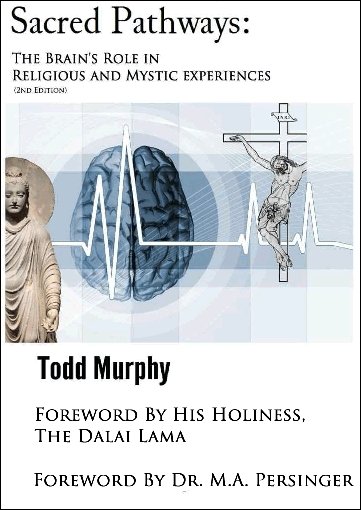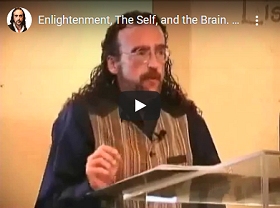Enlightenment as a Neural process; a forensic look at the Buddha’s transformation.
“Forgetting About Enlightenment”
Todd Murphy
NOTE: The author suggests his more recent book on this subject as a better presentation of this idea. There is also a youtube lecture.

Spirituality & The Brain (Home Page)
Enlightenment is a rare experience, and so are visions of God. The experience of God has been produced in the laboratories of Laurentian University’s neurosciences program, and is the subject of a book by the program’s director, Dr. M.A. Persinger. The book’s conclusion, that the ‘God-experience” reflects specific neural activity, is quite a radical notion for the western world. Much of the East, on the other hand, places it’s crucial emphasis on enlightenment. The theories and hypotheses used to explain the experience of God should also be able to account for Enlightenment. If not, then they cannot be the platform for a synthesis of science and spirituality. Neurotheology should include the traditions of Asia along with those of the West.
The Buddhist and the Hindu concepts, like other ideas from the middle ages, may not be a very good approximation of reality. The astronomy, anatomy & physiology, biology, meterology, and geology (just to name a few) of the ancient cultures were, without exception, all discarded as science progressed.
No matter how poorly they may describe reality, older ideas linger until a replacement appears. The cognitive science of Asia has been an effective tool for changing human consciousness, but it’s replacement has only appeared recently.
We’ll be discussing enlightenment in terms of this new science in this article. It took so long because none of the brain’s activities; the phenomena that cognitive science studies look at, can be seen directly. Astronomers could see the activities of the stars and planets, but medieval works dealing in emotion and cognition were mostly for spiritual practitioners. And they can’t see their brains, but they can see the phenomena that different states of consciousness produce.
The medieval discussions of consciousness were always goal-oriented; In the West, it was to prevent ‘sinful’ thoughts and feelings and to unite as closely to God as possible. In the East, their purpose is to help conquer anger, greed, sadness, ‘ignorance’ and to ‘seek enlightenment’. Of course, I’m speaking of the mystic traditions, not the popular religions.
Because the contexts for these ideas were always sacred, questioning them can seem a bit profane; even crude. But, now that the understanding of consciousness is coming out of the dark ages, we need to have a fresh look at the phenomena and experiences they address.
Sure, God’s creation was brought down a notch when ‘his’ earth stopped being at the center of the universe, and that may have detracted from it’s beauty. But only for those whose concepts of beauty were limited to seeing “His” creation. And the satellites, that could never have flown in an earth-centered cosmos, work just fine.
In the same way, the new view of spirituality will replace the old one in the minds of many, and for some, this will seem crude. But the spiritual practices and techniques will only become more effective.
If you look at the Hindu and Buddhist tales of enlightenment you’ll find that they aren’t quite sure what it is. Many words are used to describe it, all of the sounding equally exalted in English. Liberation, perfection, freedom, the ‘cessation of the illusion of self”, “crossing over to the other shore”, “truth – consciousness – bliss” (satchitananda), “the supreme awakening”, “great orgasm” (mahamudra).
Some “Arahants” – enlightened ones, as they are called, can remember their past lives, and others can’t. Some of them have psychic skills, and others don’t. Some are so articulate they can help others reach ‘it’ effectively. Others don’t say a word. Some of them can do that water-into-wine thing. Others can’t. Some of them live in perfect, unending bliss, and others are beyond all emotions, even the positive ones. Some attain ‘it’ and see the futility of the consciousness in which almost everyone lives. They just go off and die somewhere (approved by the Hindu “Laws of Manu” as an acceptable form of renunciation). Others are said to practically become immortal. For some, the sensation of having a self is changed, now somehow ‘perfect’. For others, it dissolves and become ‘at one’ with ‘the father’ or ‘the one’. In Buddhism, it’s said to have ceased to exist altogether.
The only thing that all of these traditions all agree on is that to get there is to end a discomfort intrinsic to being alive.
And I have a feeling that, although it’s possible to arrive there, what so many teachings seem to present as one state of consciousness is actually a whole range of states.
States of consciousness are supported by patterns of brain activity. And all brain activity takes place within thresholds. The enlightened states may only be available to a few people with unique neural profiles; people with especially high or low thresholds in crucial brain parts.
For people who are ‘seeking’ enlightenment, the crucial question is HOW high or low. If it’s too difficult, normal brains might not be able to manage it. But, normal brains don’t care very much about it either, so there’s no loss, really. People who are not prone to altered states don’t get the sense that their fulfillment lies in developing their consciousness. For them the the peak moments of their lives, the ones they are most likely to try to achieve again, will lie within the range of normal states of consciousness.
So even to be interested makes it a little more likely. But the very extremes in states of consciousness are usually quite rare. No matter how frightened or overjoyed you may have been, the annals of neuroscience can find someone whose had it more intensely. The odds are good that unless you are prepared to put unrelenting efforts, you’re not going to make it.
If we pretend that a healthy mind is one that’s always changing in some way, and enlightenment is a coping mechanism for adjusting to the sensation of bliss once it appears, then we’re left wondering if it’s all that healthy to be “enlightened”.
When an acolyte attains a new state, they are usually a bit bowled over. “It’s all just too much!”. Like a shy teenager who turns away from the person the have a crush on (even though they might be in total bliss), they often want to stop.
Enlightenment might be a way of stopping it, when its all too much, and of avoiding what lies ahead.
There may be real states that fit some of what’s been said about enlightenment. And they might even endure, some of them.
But they could be enduring the way an image endures when the you push the <pause> button on a video machine.
Of course, that’s no way to watch a movie. And trying to get enlightenment is no way to enjoy having a human consciousness. What would you think of a carpenter who spend so much time sharpening his tools that he never got around to woodworking?
I need to be frank on one point: I am not enlightened.
We need to drop the idea that we’re not allowed to talk about enlightenment unless we are enlightened ourselves. That only a Buddha (that’s a REAL Buddha) can talk about Buddhahood. While many of it’s experiences are ‘beyond words’, the meeting of science and spirituality demands that nothing be beyond discussion.
However, even though I am not a Buddha, I know a bit about the brain. So let’s get started.
The sense of self is said to change when a person becomes enlightened. They no longer ‘identify’ themselves with, or take their identity from, the ‘old’.
No matter what else they may be, they are now “another person”.
The human sense of self is maintained in the limbic system, and the limbic system exists on both sides of the brain. Each structure on one side that feels good to us (when it’s busy) is complimented by another on the opposite side that feels bad.
So, for most people, an emotional structure called the amygdala feels good on the left, and bad on the right.
And, for most people, a cognitive, thinking structure called the hippocampus feels better on the right and worse on the left (11).
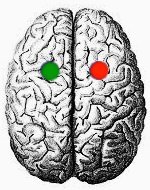
The Amygdala – an emotional structure. The left is specialized for positive emotions, and the right for negative ones.
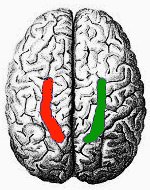
The Hippocampus is a cognitive structure. The one on the right is specialized for positive expectations (and cognitive style) and the one on the left for negative ones.
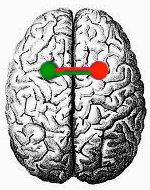
The Anterior Commissure includes two-way communication between the two amygdala(s). It’s 38% larger in women than men.
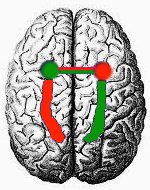
These structures are the foundation of the limbic system, here color coded with the ones that feel positive when excited. Green = Positive Red= Negative
These two brain parts are next to each other. Intergrown, in fact. And a normal brain has a positive and a negative one on each side. However, some people have ‘left-handed’ limbic parts. For them, the positive amygdala will be intergrown with the positive hippocampus. Communication between the two will be much easier than in a normal brain. The other side of the brain will have strong communication between the negative hippocampus and the negative amygdala. Such an individual might find themselves very emotionally labile, or sensitive.
But when we stop to recall that most spiritual practices exclude negative thoughts and emotions, then it seems possible that long-term practice might eventually stop their occurrence. More likely, a threshold might be passed that will leave positive emotions with lower thresholds than negative ones, and positive expectations for ongoing events becomes easier than the opposite.
The idea that meditation ‘works’ by starving negativity rather than feeding virtue is supported by a recently-published study.
A group of meditators were given questionnaires that asked how often they experienced a range of altered-state experiences. Surprisingly, the study found that the whole group, no matter how long they had been practicing, were no more prone to altered state experiences than anyone else (1) . Their practice was transforming them, but they were not experiencing meditation-like moments in their daily lives. So what changed as they ‘grew’ in their practice?
The answer, for which the group was not queried, may be that they experience less negativity; fewer moments when they become caught up in fear, anger, sadness, etc.
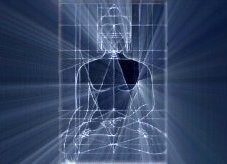 If we accept that meditation is conducive to enlightenment, and that the moments when meditation appears “in daily life” are moments when negative states are wholly absent, then we get a new definition of enlightenment.
If we accept that meditation is conducive to enlightenment, and that the moments when meditation appears “in daily life” are moments when negative states are wholly absent, then we get a new definition of enlightenment.
The complete absence of all unpleasant subjective states. This is why it takes such unrelenting efforts. Fear, for example, is a powerful adaptive ally. Each thing that enters our perception is ‘scanned’ to see if it’s a threat or not. A threat to our social status, self-esteem, livelihood, authority, or even our lives, when we have to. Becoming enlightened would mean not doing this any longer. To stop ‘scanning for danger’ will mean changing the bunches of pathways (“matrices of neurons”) that support the human sense of self, because both ‘you’ and ‘your fear’ share crucial brain parts.
In all but a very few human brains, seeking enlightenment is looking for water to flow uphill.
However, the appearance of a few brains in the population for whom the experience is easy, or impossible to avoid, is also bound to happen. The spectrum of human ‘types’ is very wide, and if there are those whose negativity is special enough that they need to be locked away, then there will also be those whose positivity will be equally special. And the most extreme among them might be prone to buddhahood. But, life can improve a lot for those who do not indulge in fear, anger, and sadness. That way MIGHT lead to final liberation, but it SURELY leads to less of what the Buddha called “suffering”, the discomfort intrinsic to being alive.
The absence of negativity as a definition for enlightenment is consistent with most Hindu and Buddhist teachings, even though it is, in fact, a different definition. Most older meanings for the word come from the bliss and freedom, or the truth. Or the appearance of a new self. Or the elimination of the old one. At best, these aren’t very clear. They all sound quite exalted, but any of them could be used to talk about several states, not just the one the Buddha attained.
One clue for looking at the enlightened state in terms of the brain is that it can happen gradually or suddenly. The Zen Buddhist tradition even goes so far as to categorize enlightenment in these very terms.
Gradual enlightenment is easily explained in terms of more ordinary neural mechanisms. The consistent practice conditions the individual to suppress negativity, so that more positive (and adaptive) emotional and cognitive responses can appear. Over time, changes on the smallest levels of brain activity (such as synaptogenesis, kindling, synaptic dropout, etc.) alters the sense of self that relies on our thoughts and feelings.
Change the brain parts where ‘self’ happens gradually, and you will slowly change the sense of self. Change them quickly, and ‘you’ will, too (10).
It might be a good idea to look at what the phrase ‘sense of self’ means. The sense of self, whatever else it is, is disturbed in ‘disorders of self’. These are the ones where a person’s identity is lost in their symptoms. Schizophrenia and dissociation are just two examples. These are now being found to involve specific disturbances in the limbic system. Further, there is a characteristic EEG signature that occurs in waking and in dreams, states in which the self is coherent enough to process present experience into memories. It’s called the 40 hz component, and it involves the limbic system, too.
Sacred Pathways: The Brain’s Role In Religious and Mystic Experiences. A new integration of science and spirituality based on brain activity and human evolution.
By Todd Murphy
Foreword by H.H. the Dalai Lama
506 pages, paperback
See it HERE
“In this book, Professor Todd Murphy recounts what he has discovered about the brain’s role in religious and mystic experience; findings that interested readers will no doubt find illuminating”… His Holiness, The Dalai Lama
Another limbic set of phenomena is hallucinations. Limbic stimulation has elicited hallucinations in scores of studies, using a variety of stimulation techniques. The limbic system is heavily intergrown with the surface of the temporal lobes, and there are even maps of the temporal lobes, showing what areas are most likely to yield which kinds of hallucinations.
So, following the rule of science that the simplest explanation is probably the closest to the truth, two things about the sense of self stand out.
One is that the sense of self is partly made up of language. Although it’s different for each person, we maintain a constant stream of inner dialog, talking to ourselves. We rehearse conversations before we have them, and when we lose an argument, we then spend time thinking of what we should have said.
Our self-esteem is VERY sensitive to what other people say to us. The phrase ‘self-esteem’ uses the word ‘self’. Here, too, if the phrase has any meaning, then our sense of self is a very linguistic thing.
The second simple thing about the sense of self is that it may be an hallucination. The brain parts that support it are also the ones behind hallucinations. And, in looking for the human ‘self,’ (not the same as consciousness) science is coming up empty-handed, or with too many (overly-complicated) hypotheses. Cognitive science understands quite a lot about the modalities in which it operates, but not much about what holds them together.
There is some understanding about the brain’s activity keeping consciousness ‘bound’ together (5), but the mechanism that makes us feel we are real to ourselves is still something of a mystery.
What we can talk about this area is the sense of self. We experience ourselves as real the same way we experience anything else. Through our senses.
But which sense do we use to perceive our “self”?
The answer I suggest is that there is a sense, that uses all the neural substrates of the other senses as it’s organs, and that has no ‘percept’. Instead, it only hallucinates. And it has only one hallucination. The self. Or rather, the selves. We have two of them, one on each side of the brain.
The one on the left (where the language centers are) is the most active, so our experience of ourselves is shaped by words. Our own inner dialog and the words we hear from others. The one on the right, the silent ‘self’ is constantly overwhelmed by the verbal ‘self’. It remains subordinate.
Now, lets’ return to our subject. Enlightenment. We mentioned before how gradual enlightenment might be seen as a slow suppression of negative thoughts and emotions that can change the sense of self through rather ordinary neural mechanisms.
Sudden enlightenment is quite another story. There, only one neural mechanism is really implicated: the interhemispheric intrusion (2, 3, 4).
Very few models of brain activity can encompass really sudden shifts in states of consciousness. While a seizure might be invoked to explain the suddenness of the event, the moment of enlightenment is not a recurring event the way seizures are. In the classical descriptions, enlightenment forever alters the sense of self. In a good way. And only once.
The idea behind the “interhemispheric intrusion” is that when the activity in one brain structure becomes so elevated that it goes past a certain threshold, it needs to escape or vent into another. It gets it name from the notion that right-hemispheric phenomena temporarily crowds out phenomena from the left. The right-sided phenomena intrudes on it, so to speak.
An interhemispheric intrusion can precipitate an event called ‘synaptic dropout’. This is when synapses (connections between nerve cells) actually drop out of service after excess input. “Burn out” might be a better term, except that the event, and the following dropout do not happen at random.
The limbic system is composed of structures, and the structures are composed of nuclei (or layers).
It’s possible that the specific nuclei (or layer) within any limbic system that can bear the least activity will be the one to initiate an interhemispheric intrusion, and that will be different for different people. A chain is only as strong as it’s weakest link. And an overloaded limbic system may well ‘dump’ it’s load of electrical activity when it’s most unstable nucleus reaches it’s limit. The specific nucleus that’s most unstable may well reflect an individual’s history.
When we look for interhemispheric intrusions in other people’s tales of spiritual transformation, we’re looking for epiphanies of any sort that follow VERY negative episodes.
In many cases, we find them. The Buddha was tortured by the demons of Mara the night before his enlightenment. Jesus emerged from the desert after a meeting with Satan. Ramakrishna’s moment happened following an episode of extreme dysphoria that left him convinced he was about to die.
For the limbic system, there are extensive connections available for shunting the activity to the opposite side if the brain. The most important of these is the anterior commissure, which connects the amygdalas on each side of the brain (it also connects the surface of the temporal lobes on each side).
When the phenomena of the dysphoria are cognitive, then the dropout seems most likely to be cognitive, as the specific signals embedded in the blast of activity may well be ‘coded’, so to speak, to cognitive functions. If the dark night of the soul is made of emotions, then the enlightenment that follows should find itself with an emotional quality.
This seems to predict something we see in the Hindu and Buddhist traditions. Some teachers (like H.H. The Dalai Lama and the Teacher Ammachi ) emphasize compassion and a state called “lovingkindness”. An emotional orientation. Others, (like the Zen masters and the Vedanta teachers) emphasize awareness of the present moment. A ‘cognitive’ orientation.
Each broad approach recognizes the validity of the other, but still retains it’s own emphasis.
Back to our theme.
The Buddha’s life story has already been told many times. Here, we need only to recall that he was the son of a king, highly educated, and had a very sheltered childhood. His sheltered childhood is literally legend. His father tried to protect him from anything that might shock or disturb him. In neural terms, this meant his right amygdala was quite quiet.
 Before the Buddha’s enlightenment, he practiced several techniques, including long periods of intensive fasting while in concentration.
Before the Buddha’s enlightenment, he practiced several techniques, including long periods of intensive fasting while in concentration.
Later, he saw some things that disturbed him, including a dead person. These experiences shocked him so deeply that he renounced his title to the throne, and became an intinerant monk. He studied with several teachers, and learned techniques that all involved concentration. The scriptures say that he practiced meditation with real dedication.
Imagine a person was doing long periods of meditation and spending many hours a day suppressing all negative thoughts and emotion. With time, their right (fearful) amygdala would become increasingly quiet.
One day, they stop their practice, as the Buddha did after seeing that his had gone too far. Their right amygdala, and the whole set of things it’s wired to, would soon begin to activate themselves. After the long history of inactivity, all the negative emotions that belong to the right amygdala would emerge into the person’s awareness. A dark night of the soul, so to speak. Especially if an outer stress were to activate it naturally. And the Buddha had one. His disenchantment with the ascetic path caused him to lose all his friends. All at once.
A spiritual discipline that ‘tasks’ the left amygdala, such as remaining aware of an emotion without acting it out in any way, or responding to all negative emotions with a verbal prayer (ex: Jesus, have mercy on me) will be raising the level of the left amygdala’s activity, as right amygdala’s functions are increasingly suppressed. As one amygdala’s activity increases, the opposite one decreases, according to the theory of vectorial hemisphericity (6).
But, we should remember that the right amygdala, (whose activity supports low self-esteem and fear) is wired to many other parts of the brain, not only it’s left-hemispheric counterpart. As it’s activity decreases, all the parts it’s connected to must adjust themselves to accommodate, including the opposite amygdala. Scores of brain parts are involved, with varying degrees of intimacy.
And it’s less work for the brain to try to re-establish the older amygdaloid settings, which will involve adjusting only one brain part. (Older means before spiritual practice ) While this is happening, the right-sided amygdala; the one that sustains negative emotions, including sadness and fear, must be active (according to the principle that neural structures must be activated in order to grow or learn – including learning NOT to do something.)
And the right amygdala is connected to many other brain parts. When they’re held off by ongoing spiritual practice, they’re quiet, but as soon as any of them are initiated, the whole matrix of right amygdaloid activity can burst into activity, in an attempt to re-establish themselves. Metabolic snapback is the name for this process when it happens in response to magnetic signal stimulation, and when it happens (in theory) to keep rarely used matrices of neurons active, it’s called dynamic stabilization. Remember, the amygdala itself is much more labile than the structures it’s connected to. It’s more prone to localized seizures than any other part of the brain (7).
If the suppressed matrix of right amygdaloid connections were large enough, their re-emergence might elicit enough activity to overwhelm it.
First, the activity would spread to the right hippocampus, a brain part that’s involved with inner imaging, most importantly, the visual components of memory. (It also consolidates short-term memory into long-term ones.)
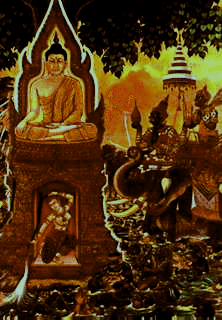 The Buddha touched the Earth to call on her to witness his vow to become enlightened. In this Thai image, the Earth mother is shown appearing to flood the demons of Mara, and Mara himself is shown on his war-elephant offering his devotion after his defeat.
The Buddha touched the Earth to call on her to witness his vow to become enlightened. In this Thai image, the Earth mother is shown appearing to flood the demons of Mara, and Mara himself is shown on his war-elephant offering his devotion after his defeat.
Now we need to look at another amygdaloid function. Or set of functions. Relating to others. It helps us recognize what facial expressions mean, and in the emotional ‘charge’ of words. These are very social functions. They’re initiated while relating to others
Now, what do you get when you ‘socialize’ a ‘vision’ with an extremely elevated (“maxed-out”) right-amygdaloid emotion?
A vision of another person. One that you don’t like. Like a demon. Or Mara, lord of Evil. Or Satan (8).
The hippocampus is important in contextualization, a crucial component of almost all cognitive processes (9). When the negative emotions from the right amygdala spill into the right hippocampus, they are given a context. A demon of one sort or other. The amygdala’s social functions favor anthropomorphic hallucinations, so the appearance of a ‘bad guy’ becomes more likely as the experience gains in intensity.
OK. Now we’re up to the night of the Buddha’s enlightenment.
If you know the story, you know that Mara is said to have disappeared after the Buddha touched the earth, calling on her to witness his vow to attain enlightenment. If our definition of enlightenment is valid, then this would have included continuing to condition the suppression of fear, sadness, etc.
The activity in his right hippocampus, we might guess, now had nowhere to go but back into the right amygdala.
But it was already loaded to the max. So it took the next available route. Across the brain to the left amygdala. With so much force that large numbers of synapses that had previously functioned to inhibit traffic from the right amygdala to the left were overloaded and dropped out.
 The Buddha became enlightened at dawn one day, gazing at the morning star.
The Buddha became enlightened at dawn one day, gazing at the morning star.
As the left amygdala bursts into activity, the pressure is taken off of the one on the right, and the right hippocampus no longer needs to vent its activity. It remains busy. That enhances non-verbal cognitive processes at the expense of verbal cognitive ones.
The mind is ‘silent’. “Suffering” is ‘ended’ as the left amygdala’s positive emotions now predominate. Bliss, ecstasy, unconditional love, etc.
The story tells that he sat and looked at the morning star, venus. This suggests how he might have gotten hold of himself. By engaging a cognitive task. Putting all his attention into looking at a point of light, a common introspective task for meditators who experience inner points of light. However, Venus is not as bright as the sun. It will disappear when the sun lights up the morning sky. I would suggest that his limbic system was very labile or unsteady just then, and given it’s contribution to the sense of self, it might have facilitated an interhemispheric intrusion; one that followed the cognitive context created shortly before, when he ended his episode with Mara. In the new context, a new sense of self emerged. One that wasn’t based on language any longer. His non-linguistic sense of self became dominant. His choice to look off into space after touching the earth activated his right hippocampus again (due to it’s involvement with spatial perception). This time, it’s phenomena combined with the left amygdala’s (affective) contribution to the sense of self. So that the dominant sense of self acquired a non-linguistic cognitive basis.
In other words, when The Morning Star vanished, so did he.
THE BUDDHA’S ENLIGHTENMENT IN A NEURAL MAP
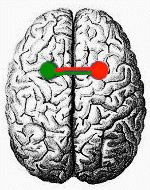 1) To begin, Gautam Siddartha’s brain has both amygdala active, and fully connected to each other. In other words, more or less normal.
1) To begin, Gautam Siddartha’s brain has both amygdala active, and fully connected to each other. In other words, more or less normal.
(Adolescence to renunciation)
![]()
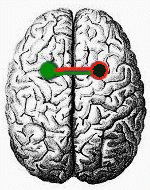
2) He Begins Meditation. With time, his RIGHT amygdala becomes less and less active.
His emotional life is dominated by his left amygdala.
(Period spent ‘seeking’ – several years)
![]()
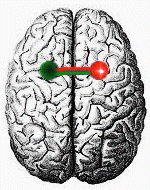
3) He stops his practices, after seeing that they’re too extreme. His RIGHT amygdala bursts into activity. He becomes forceful with himself, and vows to reach his goal or die under the Bodhi tree.
(Abandonment of harsh practices – a few days)
![]()
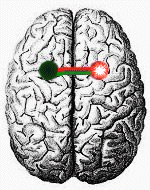
4) The RIGHT amygdala becomes active enough to dominate his state of consciousness, and he experiences many unpleasant states.
(Night of enlightenment – a few hours)
![]()
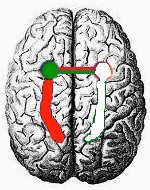
5) Right amygdaloid activation spreads to the right hippocampus, a crucial contributor to inner vision, including visual memory. His experience takes on a visionary character (The demons and daughters of Mara).
(Night of enlightenment – a few hours)
![]()
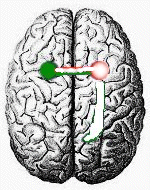
6) His right amygdaloid and hippocampal activity goes past it’s maximum threshold, and with no where else to go, the activity bursts across the brain to the left amygdala with such force that synapses that inhibit right-to-left activation drop out. So do the ones from the right hippocampus to the right amygdala.
(Moment of enlightenment – Venus is obscured by the Sun)
![]()
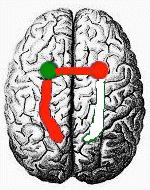
7) Now, he’s enlightened. Most RIGHT amygdala activity is shunted to the left. There are still ways to access the right amygdala, but they’re now routed through other parts of the brain. His right hippocampus now has as much or more access to the left amygdala than it does to the one just next to it.
The Synapses Inhibiting Activity Towards The Left No Longer Function.
![]()
The neural event happening with the Buddha’s enlightenment would have consisted of a dramatic spillover from the right amygdala to the left. So dramatic that synapses operating to inhibit communication in that direction were overloaded and dropped out.
Thereafter, ALL right amygdaloid activity is shunted over to the one on the left. All experiences evoke positive emotions. And, because of our postulated hippocampal information embedded in the blast of amygdaloid activity from right to left, we’re forced to draw a conclusion. The dropout of right-left inhibition will also have facilitated right to left hippocampal communication (intercalation), but not in the opposite direction.
The Buddha’s limbic system now lacks some of the valves that limit the flow of activity from the right amygdala to the left. The other direction now has much lower thresholds. All events now have a positive emotional meaning, or at least no longer have negative ones. With no significant use of the right amygdala, crucial in the maintenance of fear, there is literally nothing to be afraid of.
We should expect that the dropout would favor those synapses that communicate with the right hippocampus from the left amygdala, via the right amygdala, because we’ve already theorized that the right hippocampus would have been more active than the left just before the moment of enlightenment. The Buddha’s education and intelligence would have contributed to his hippocampal activity overall before his renunciation. His developed cognitive skills would have left him predisposed to a strongly cognitive component to his new state.
The Buddha’s limbic system now has all activity in it’s right side immediately recruiting the left amygdala. The left amygdala, in turn, can still recruit both left and right hippocampus. His left amygdala could now access both linguistic and non-linguistic cognitive modalities equally. Evidently, it was an either / or proposition at first.
The story goes that he sat under the Bodhi tree for a week after his enlightenment without speaking to anyone.
In neural terms, this make sense. Remember that his enlightenment seems to have involved changes in the amygdalas on both sides of the brain, but the hippocampus on only one of them. The right side. The non-verbal side. The one that “knows not through words.”
The Buddha saw, we are told, that his sense of self was an illusion. He compared it to a house whose ridge had been broken by his new perception “never to be rebuilt”. What he was experiencing as the illusion of self emerges, in this discussion as the removal of the left-hemispheric, linguistic sense of self from dominance. The sense of self that’s reinforced through language ended it’s dominance over the Buddha’s subjective experiences. His enduring command of language and frequent use of logical analysis in debating other teachers evidences that he still had a fully functioning set of left hemispheric faculties.
The Buddha ended his enlightenment, we’re guessing, with a very quiet left hippocampus, and a right amygdala so compromised by his enlightenment that it could no longer ‘contain’ any significant activity. Remember that the synaptic dropout will have occurred in one direction only. Right amygdaloid activity can still be initiated, but only driven by the one on the left. Adaptive right amygdaloid functions would remain (one example might be the recognition of negative emotions in other people). But now, they are accessed by far fewer surrounding parts.
Now, when the non-verbal hippocampus is activated, it is far more likely to activate the amygdala on the opposite side of the brain.The story tells that he looked at his new state, and concluded that, NO WAY could this be taught or explained to anyone.
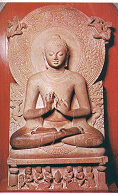 This Statue, found at Sarnath, in India, shows the Buddha giving his first sermon, “Turning the Wheel of the Law”.
This Statue, found at Sarnath, in India, shows the Buddha giving his first sermon, “Turning the Wheel of the Law”.
Then, we’re told, he was visited by the gods. Another ‘visitor’ experience, just like the ones the night before his enlightenment, only this time, the left amygdala predominates, and he is visited by the gods instead of the demons of evil. The gods ask the buddha to make the effort to teach, because there were a few people who were so ready for the experience that his words, if he could find them, would be of help. So the Buddha sat and developed his first sermon. The sutra of the turning of the wheel of the dharma.
Not surprisingly, the subject was how thoughts, feelings, the senses, and psychological tendencies instantiate the illusion of self (as it recapitulates itself in response to each experience). And how that introduces a discomfort intrinsic to being alive.
In order for this model of the Buddha’s sudden enlightenment to work, we have to suppose that his non-verbal hippocampus was heavily involved; more so than his verbal one.
If he had a ‘left-handed’ hippocampus, that would have made enlightenment much easier in neural terms. The positive amygdala and the non-verbal hippocampus would already be closely interconnected (now being on the same side of the brain). The thresholds that the episodes in his enlightenment would cross will be much lower. The period of his practice, when he trained himself to stop indulging in fear and sadness, would also have been much easier in this case, too. More positive cognitive and emotional responses to things would have fed back on each other, leaving one hemisphere neatly out of the picture. Supressing negative ideation and emotion in a brain with a ‘reversed’ or ‘left-handed’ brain part means taking activity away from two parts on the same side of the brain.
The Buddha claimed to have helped many, many people become enlightened. However, these claims of large numbers of “Arahants” don’t appear in later scriptures.
The Buddhist scriptures may have bent the truth a bit to make the Dharma; the teachings, seem more effective than they really are. There is also the possibility that the Buddha’s own presence, while he was alive, may have provided crucial support that was absent after his death.
The present time finds enlightenment as a rare phenomena at best.
One possibility is that the Buddha was prone to the experience due to a unique neural profile.
And that his teaching makes enlightenment seem much more probable than it really is. Not because the dharma contains any serious mis-apprehensions in it’s field, but because it contains no measures for the thresholds that have to be crossed. While some scriptures acknowledge that there are various personality types more prone to sudden enlightenment, there has never been any way to distinguish how prone someone is to the experience. Except to try it.
Perhaps, for normal brains, the experience is not possible at all. Or rather, that it’s so unlikely that a life spent chasing it may only induce gradual changes, but fail to attain the radical change in their sense of self they’re looking for.
So, what’s a poor seeker to do?
A much more intelligent approach, if you think that enlightenment may not happen in this lifetime, is to forget about the maximum potentials for your states of consciousness, and to focus instead on your most immediate potential.
You really can’t say that there’s anything wrong with your life because you’re not enlightened. Something might be wrong, but it’s not unenlightenment. More likely, it’s too much anger, sadness, loneliness, sexual frustration, fear, or behavior patterns and long-standing traits you keep repeating to your own detriment.
If your life were totally comfortable, why would you bother with spirituality?
I don’t want to discourage anyone from trying to become enlightened, but it might be more germane to focus on what you want to get rid of in doing spiritual practice, instead of what you want to attain.
So why meditate?
Because it increases your sensitivity to your own anger, fear, sadness etc.. In meditation, you learn to be aware. As that happens, you become aware of your own emotions and feelings along with everything else in your experience, right as they happen.
And you will probably find that you’re in some sort of discomfort most of the time, and that most of it comes from within.
As you get more aware, you see that each negative thing you create for yourself is a process. It starts off with hearing somebody say something you don’t like. You have an emotional response. Your body gets tense. Your thoughts sprint into looking for a response. It’s a whole process, not just one event.
The more aware you are, the sooner you notice that it’s happening. If you notice it quick enough, you can re-route things. The Buddha put his attention into two acts, if we can believe the stories. He remembered his vow. That’s memory retrieval. That’s a hippocampal task. Then he looked at the morning star, venus. Far off in space. That’s spatial perception. Another hippocampal task.
He re-routed his brain’s activity away from his amygdala in the process, and that’s what you can do, too. In response to your own negativity. One of the functions of the hippocampus is monitoring inner state. Just stopping to look at what’s actually happening during a moment of negativity can change it’s course.
Do it enough, and you may find that you get the habit of not completing your negative patterns.
If your negative patterns don’t go anywhere, you might find that as the brain parts that support negativity become less active, the sense of self these same brain parts support will also change.
According to one Buddhist tradition, the Buddha became enlightened through:
“….the Middle Path of moderation based on the practice of virtue (sila), concentration of the mind (samadhi), and the intensive analysis of all psycho-physical phenomena that finally leads to full understanding of things as they really are (panna). “
Virtue could easily mean the suppression of negative thoughts and feelings. Not by tensing up while they happen, but by choosing different responses when they occur. Respond to anger by choosing to think about things that evoke compassion. Respond to sadness, anger, or fear by looking at what your body is feeling when they happen. Negative thoughts are not prevented so much as ignored in both of these practices. Mental concentration refers to meditation, but not for it’s own value. Rather, it sharpens one’s alertness so that the transition from angry feelings to angry words becomes explicit. While the transition is happening, anger can be re-routed. But it takes an adroit mind and a certain amount of training. Seeing things as they really are refers to the new, non-linguistic sense of self, whose perception is no longer filtered through their inner dialog.
Let me offer a metaphor.
Evolution (I mean Darwin’s theory, not the spiritual kind) works by selecting the members of a species best suited to their situation. They
live longer. They breed more. They get away from tigers better. Whatever.
The species changes in response to the reality of death. Without any planning of who they want to be, each species focuses on death, according to how it’s most likely to appear for them, in order to avoid it.
Each species ends up being whatever it is. No planning to their bodies, behaviors, and minds. Each feature is a response to something in their
evolutionary history. It helped them survive. Right at the time it appeared. “In the moment”, so to speak.
It happens because the priority is avoiding death.
When the priority is really being in one’s life; LIVING in each moment, without negative thoughts or feelings, the same thing happens. If the person avoids anything that feels like it goes against that the way a gazelle avoids a leopard or a brush fire.
In time, that individual is going to become a different person.
If they believe that there is an absolute limit on the process, like:
Enlightenment
Oneness with God
Complete purity
Liberation
Being guaranteed a place in heaven
Unconditional love
Final Realization
….or anything like these, the person will no longer have any notion about what to do to continue the process once they reach their goal. Or rather,
that it can be continued at all. And far worse, failure to reach enlightenment becomes a kind of personal failure. Worst of all, other people’s failure to try to reach it makes them seem a bit …. coarse.
When an enlightened one teaches their process as ‘the way’, they fail to see that their state might not be as fulfilling for others. One ‘enlightenment’ is about love because the PERSON is about love. Another one is about ‘being here now’ because the person is about that.
Darwinian evolution uses navigation by dead reckoning, away from death. Each species developing in its own direction.
“The Process”, if I can call it that, does the same thing.
A species that’s really improving its ability to live isn’t trying to arrive at a ‘perfect’ form.
And neither am I
END.
REFERENCES | QUESTIONS ABOUT ENLIGHTENMENT | HOME PAGE
1) Murphy, Todd & Persinger, M. A. “Complex Partial Epileptic-Like Experiences in University Students and Practitioners of Dharmakaya in Thailand: Comparison with Canadian University Students. Psychological Reports, 2001, 89, 199-206
2 ) Persinger, M.A. “Sense of a Presence And Suicidal Ideation Following Traumatic Brain Injury: Indications of Right-Hemispheric Intrusions From Neuropsychological Profiles” Psychological Reports, 1994, 1059-1070
3 ) Persinger, M.A. “Enhanced Incidence of ‘The Sensed Presence’ in People Who have Learned to Meditate: Support For The Right-Hemispheric Intrusion Hypothesis.” Perceptual and Motor Skills, 1992, 75, 1308-1310
4 ) Persinger, et al, “The Sensed Presence as Right-Hemispheric Intrusions Into the Left Hemispheric Awareness of Self: An Illustrative Case Study” Perceptual And Motor Skills, 1994, 78, 999-1009
5) Persinger, M.A. “Is there more than one source for the Temporal Binding Factor For Human Consciousness?” Perceptual and Motor Skills, 1999, 89, 1259-1262
6) Persinger, M.A. “Vectorial Cerebral Hemisphericity as differential sources for the Sensed Presence, mystical experiences, and religious conversions“. Perceptual and motor skills , 1993, 76, 915-930
7) Gloor – “The Amygdala”
8) Persinger, Michael A. “Geophysical Variables and Behavior” LV. Predicting The Details of The Visitor Experiences And The Personality Of Experients: The Temporal Lobe Factor. Perceptual And Motor Skills, 1989, 68, 55-65
9) Miller, Robert “Cortico-Hippocampal Interplay and the Representation of Contexts in the Human Brain.” Springer-Verlag, 1991
10) Persinger, M. A. “Personality Changes Following Brain Injury As A Grief Response To The Sense of Self: Phenomenological Themes As Indices Of Local Lability and Cognitive Structuring As Psychotherapy” Psychological Reports, 1993, 72, 1059-1068.
11) Persinger, Michael A.; Richards, Pauline M.; Koren, Stanley A. “Differential ratings of pleasantness following right and left hemispheric application of low energy magnetic fields that stimulate long-term potentiation”. International Journal of Neuroscience. 1994 Dec. 79 (3-4): p. 191-197
Manusmirti: “The renunciate may walk in a northeasterly direction, subsisting on water and air, until the body comes to rest”
Other Pages On This Site:
NEURAL STIMULATION:
The God Helmet | Shiva Psychic Technology
Shakti – Magnetic Brain Stimulation
Inventing Shakti
Stimulating My Brain As A Spiritual Path
HUMAN EVOLUTION:
Origins of spirituality in Human Evolution
Role of Mystics and mysticism in Human Evolution.
The Gay Male Brain in human evolution
The Evolution of Human Belief in God
Consciousness | Darwinian Reincarnation
SPIRITUAL
NEUROSCIENCE
Articles on neurotheology, (or – spirituality and religion meet brain science).
Enlightenment And the Brain
Deja Vu | Meditations from Brain Science
Romantic Love and the Brain
The Sensed Presence | God in the Brain
Spiritual Aptitude Test | Sacred Lands
The Spiritual Personality | Archetypes
Out-Of-Body Experiences | Visions
Odd Experiences – Online Poll Results
Podcasts on Neurotheology
OFF-SITE PAGES (OPEN IN NEW WINDOWS).
Different spiritual practices have different effects on the brain.
NEAR-DEATH EXPERIENCES:
NDEs in Thailand – Discussion | Thai NDE Case histories
Darwinian Reincarnation
Near-Death Experience Screensaver (Entering the Light).
Epilepsy And Near-Death Experiences
BRAIN STUFF:
Glasses For Enhanced Visual Acuity
A Diet For Epileptics?
Sex & States of Consciousness
Hippocrates on Epilepsy
The Terrorist Brain
OTHER STUFF:
